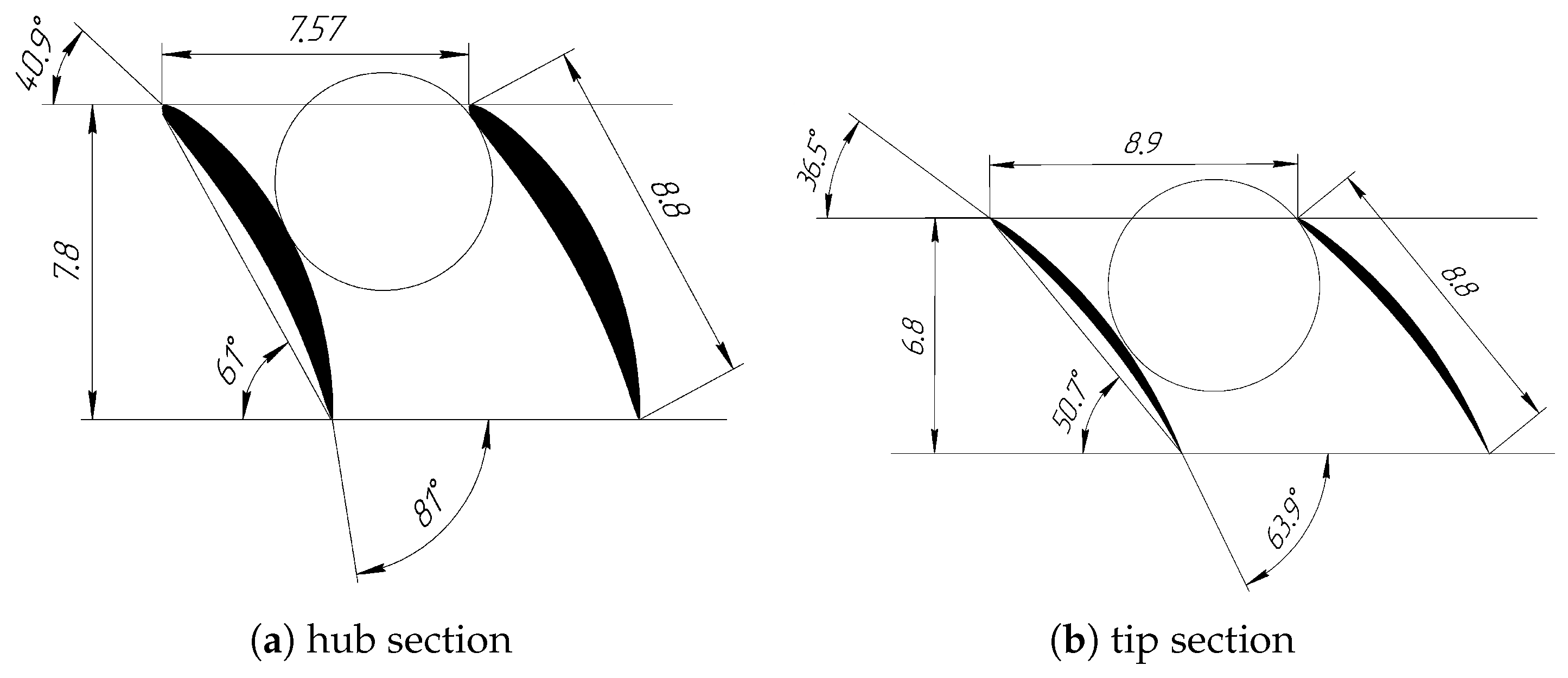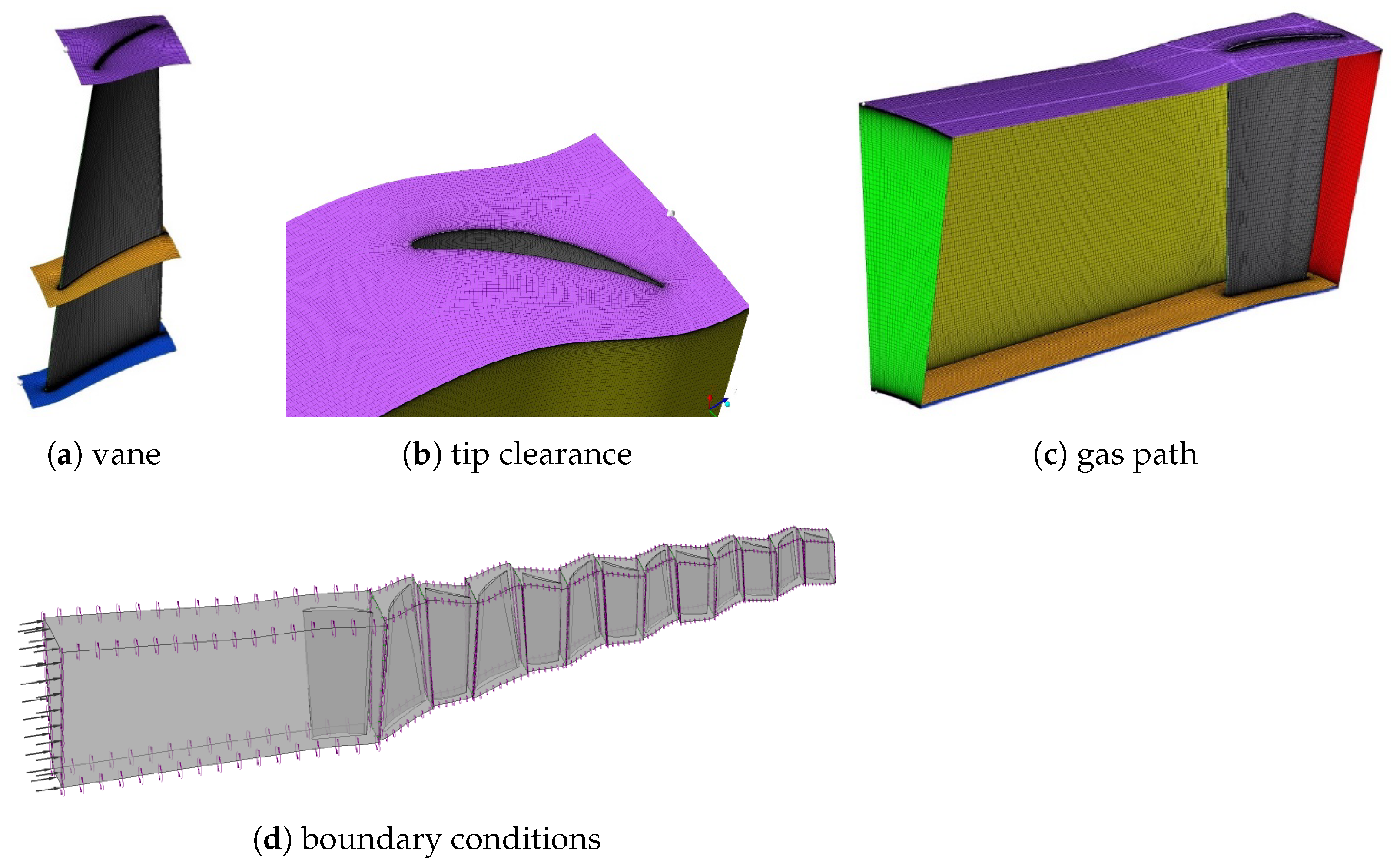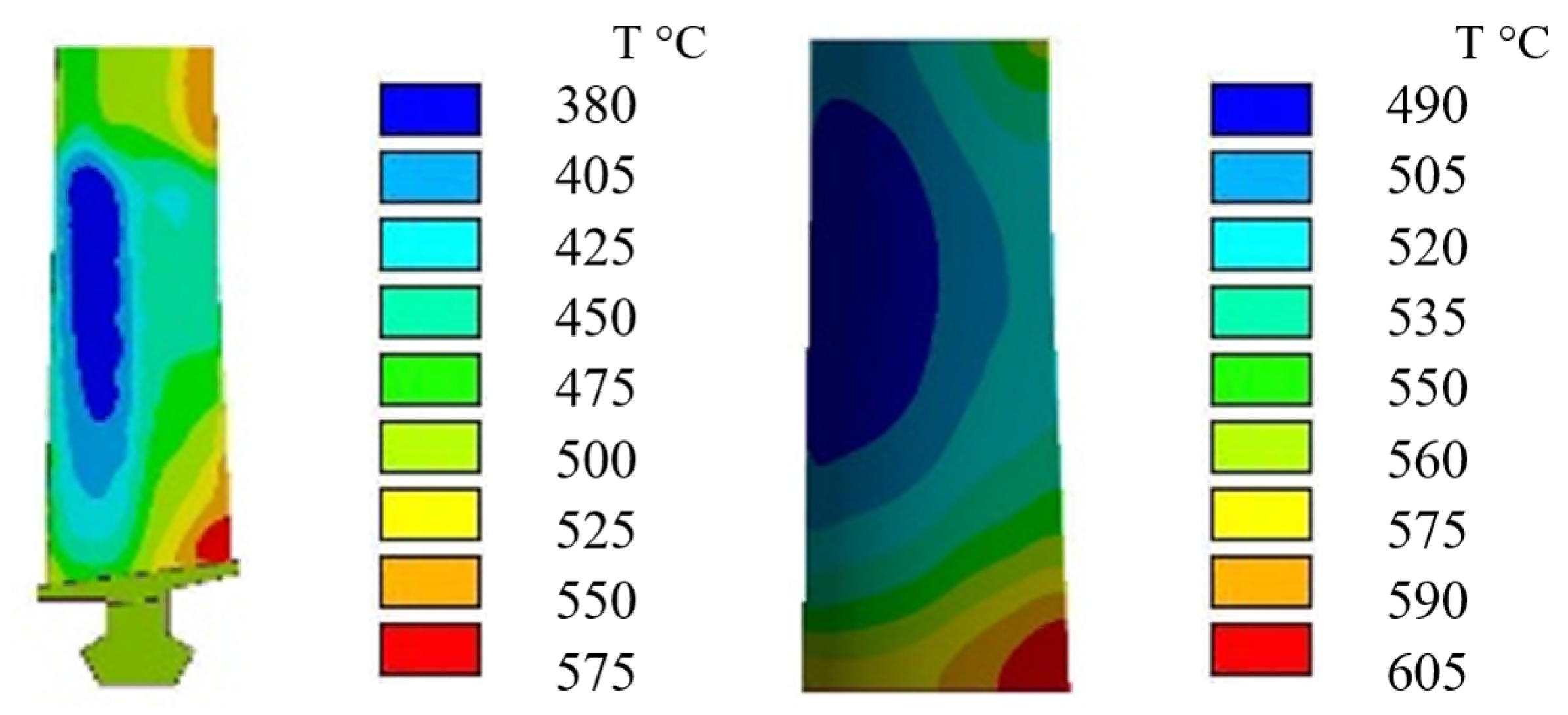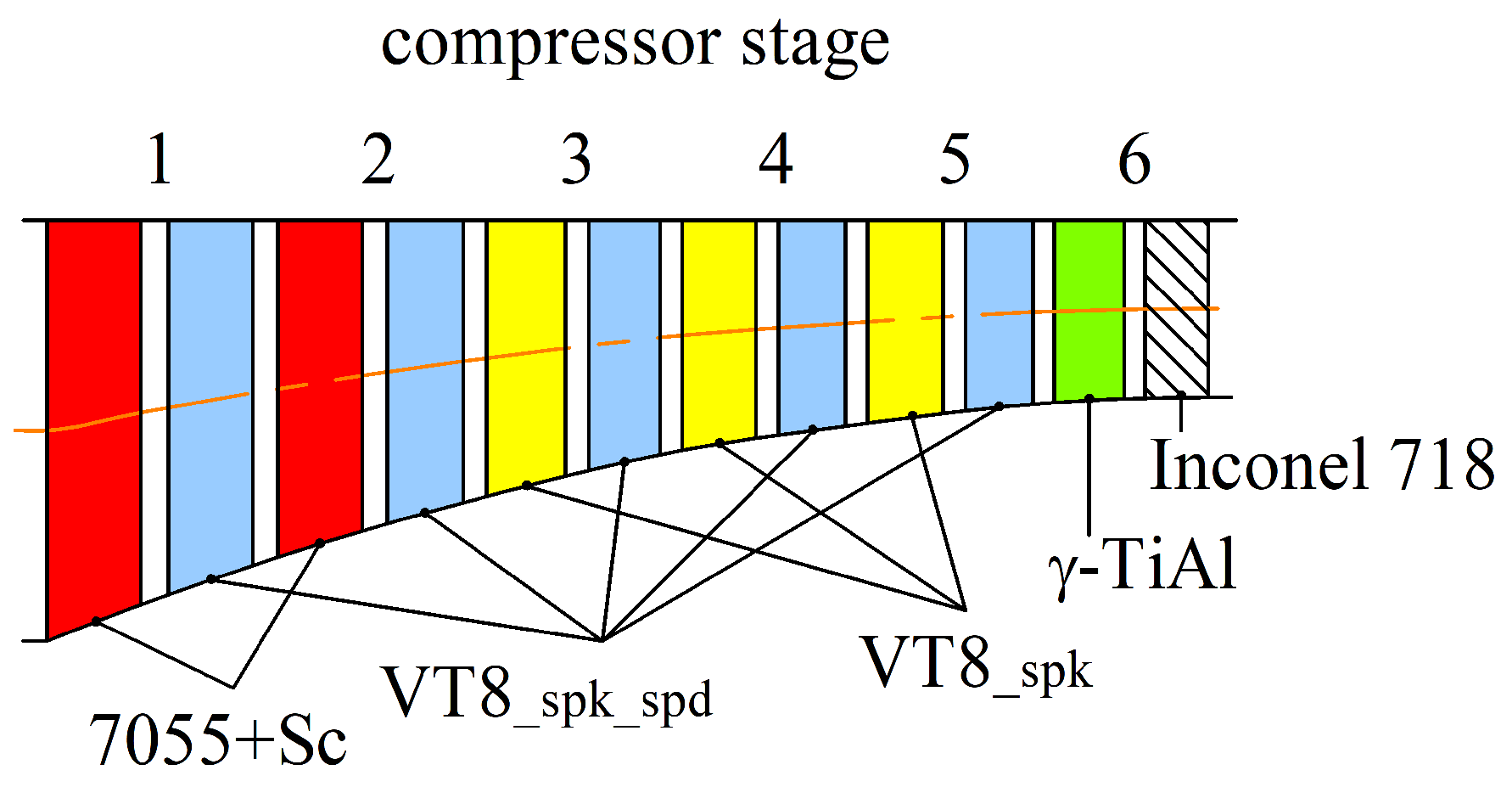Advanced Materials and Technologies for Compressor Blades of Small Turbofan Engines †
Abstract
:1. Introduction
2. Materials and Methods
2.1. Twist Extrusion
2.2. Sintered Titanium
2.3. Aluminium-Based Alloys
2.4. Strength Testing
2.5. Modelling the Compressor
2.6. CFD Model
2.7. Thermal Structural Analysis
3. Results and Discussion
4. Conclusions
- (1)
- It was found that the vanes of the first fifth stator stages can be made of sintered VT8 titanium alloy without strain hardening. Respectively, the blades of the first fifth rotor stages can be made of sintered VT8 titanium alloy, subjected to SPD processing.
- (2)
- 7055+Sc aluminium alloy, regardless of the use of TE, can be used to make vanes of the first two stages.
- (3)
- Titanium aluminides (-TiAl) processed with TE can be used for the blades of stages 1–3 and all stator stages. Considering the lower cost of sintered titanium compared to -TiAl alloy, it is reasonable to use it only for the 6th-stage vanes.
- (4)
- None of the candidate materials are suitable for making 6th-stage blades, so a superalloy such as Inconel 718 has to be used instead.
Author Contributions
Funding
Acknowledgments
Conflicts of Interest
Abbreviations
| Poisson’s ratio | |
| density | |
| conditional yield strength | |
| von Mises stress | |
| back pressure | |
| E | Young’s modulus |
| forward pressure | |
| p | pressure |
| safety factor | |
| T | temperature |
| CFD | computational fluid dynamics |
| FE | finite element |
| HPT | high-pressure torsion |
| IGV | inlet guide vanes |
| JSC | join-stock company |
| rpm | revolutions per minute |
| SE | state enterprise |
| SPD | severe plastic deformation |
| SPK | sintered metal powder |
| SST | Menter’s Shear Stress Transport model of turbulence |
| TE | twist extrusion |
| UAV | unmanned aerial vehicle |
| UTS | ultimate tensile strength |
| VT8 | Titanium wrought alloy |
References
- Telesyk. Motor Sich Engines for UAVs (Dvigateli “Motor Sich” Dlja BPLA). Available online: https://telesyk.livejournal.com/146218.html (accessed on 2 November 2020).
- Brooks, V.E. Small Turbine Engine Evolution. SAE Int. J. Aerosp. 2008, 1, 2008-01-2874. [Google Scholar] [CrossRef]
- Costa, F.P.; Henrique, L.; Whitacker, L.; Bringhenti, C.; Tomita, J.T. An Overview of Small Gas Turbine Engines. In Proceedings of the 24th ISABE conference, Canberra, Australia, 22–27 September 2019. ISABE 2019, ISABE-2019-24387. [Google Scholar]
- Weinberg, M.; Wyzykowski, J. Development and Testing of a Commercial Turbofan Engine for High Altitude UAV Applications. SAE Tech. Pap. 2001. Available online: https://saemobilus.sae.org/content/2001-01-2972/ (accessed on 8 May 2020). [CrossRef]
- Rodgers, C. Affordable Smaller Turbofans. Volume 1: Turbo Expo 2005. ASMEDC 2005, 1, 1–10. [Google Scholar] [CrossRef]
- Large, J.; Pesyridis, A. Investigation of micro gas turbine systems for high speed long loiter tactical unmanned air systems. Aerospace 2019, 6, 55. [Google Scholar] [CrossRef] [Green Version]
- Nelson, J.R.; Dix, D.M. Development of Engines for Unmanned Air Vehicles: Some Factors to Be Considered; Technical Report; Institute for Defense Analyses: Alexandria, VA, USA, 2003. [Google Scholar] [CrossRef]
- Razinsky, E.; Cae, T. The J402-CA-702-A Modern 1000 Lb. Thrust RPV Engine. In Proceedings of the AIAA/ASME/SAE/ASEE 24th Joint Propulsion Conference & Exhibit, Boston, MA, USA, 11–13 July 1988. [Google Scholar]
- Jackson, M. Titanium—21st century. Mater. World 2007, 15, 33–34. [Google Scholar]
- Leyens, C.; Peters, M. (Eds.) Titanium and Titanium Alloys; Wiley-VCH Verlag GmbH & Co. KGaA: Weinheim, Germany, 2003. [Google Scholar] [CrossRef]
- Kashapov, O.; Novak, A.; Nochovnaya, N.; Pavlova, T. Sostojanie, problemy i perspektivy sozdanija zharoprochnyh titanovyh splavov dlja detalej GTD (State, problems and prospects of heat-resistant titanium alloys for GTE parts). Proc. VIAM 2013, 3, 1–12. [Google Scholar]
- Whittaker, M. Titanium in the Gas Turbine Engine. In Advances in Gas Turbine Technology; Benini, E., Ed.; InTech: Rijeka, Croatia, 2011; Volume 4. [Google Scholar] [CrossRef] [Green Version]
- Moustapha, H. Future Technology Challenges for Small Gas Turbines. In AIAA International Air and Space Symposium and Exposition: The Next 100 Years; American Institute of Aeronautics and Astronautics: Reston, VA, USA, 2003; pp. 1–11. [Google Scholar] [CrossRef]
- Liu, S.; Shin, Y.C. Additive manufacturing of Ti6Al4V alloy: A review. Mater. Des. 2019, 164, 107552. [Google Scholar] [CrossRef]
- Salvati, E.; Lunt, A.J.G.; Ying, S.; Sui, T.; Zhang, H.J.; Heason, C.; Baxter, G.; Korsunsky, A.M. Eigenstrain reconstruction of residual strains in an additively manufactured and shot peened nickel superalloy compressor blade. Comput. Methods Appl. Mech. Eng. 2017, 320, 335–351. [Google Scholar] [CrossRef]
- Boguslaev, V.A.; Pukhal’Skaya, G.V.; Koval’, A.D.; Stepanova, L.P.; Tkachenko, V.V. The effect of methods for hardening finish treatment of blades made of titanium alloys on the state of their surface layer. Met. Sci. Heat Treat. 2008, 50, 18–24. [Google Scholar] [CrossRef]
- Zou, S.; Wu, J.; Zhang, Y.; Gong, S.; Sun, G.; Ni, Z.; Cao, Z.; Che, Z.; Feng, A. Surface integrity and fatigue lives of Ti17 compressor blades subjected to laser shock peening with square spots. Surf. Coat. Technol. 2018, 347, 398–406. [Google Scholar] [CrossRef]
- Azushima, A.; Kopp, R.; Korhonen, A.; Yang, D.Y.; Micari, F.; Lahoti, G.D.; Groche, P.; Yanagimoto, J.; Tsuji, N.; Rosochowski, A.; et al. Severe plastic deformation (SPD) processes for metals. CIRP Ann. Manuf. Technol. 2008, 57, 716–735. [Google Scholar] [CrossRef]
- Segal, V. Review: Modes and Processes of Severe Plastic. Materials 2018, 11, 1175. [Google Scholar] [CrossRef] [Green Version]
- Valiev, R.Z.; Estrin, Y.; Horita, Z.; Langdon, T.G.; Zehetbauer, M.J.; Zhu, Y. Producing Bulk Ultrafine-Grained Materials by Severe Plastic Deformation: Ten Years Later. JOM 2016, 68, 1216–1226. [Google Scholar] [CrossRef] [Green Version]
- Husaain, Z.; Ahmed, A.; Irfan, O.M.; Al-Mufadi, F. Severe Plastic Deformation and Its Application on Processing Titanium: A Review. Int. J. Eng. Technol. 2017, 9, 426. [Google Scholar] [CrossRef] [Green Version]
- Pavlenko, D.V.; Beygelzimer, Y.E. Vortices in Noncompact Blanks During Twist Extrusion. Powder Metall. Met. Ceram. 2016, 54, 517–524. [Google Scholar] [CrossRef]
- Estrin, Y.; Vinogradov, A. Extreme grain refinement by severe plastic deformation: A wealth of challenging science. Acta Mater. 2013, 61, 782–817. [Google Scholar] [CrossRef]
- Beygelzimer, Y.E.; Orlov, D.; Korshunov, A.; Synkov, S.; Varyukhin, V.; Vedernikova, I.; Reshetov, A.; Synkov, A.; Polyakov, L.; Korotchenkova, I. Features of twist extrusion: Method, structures & material properties. Solid State Phenom. 2006, 114, 69–78. [Google Scholar] [CrossRef]
- Bykov, I.O.; Ovchinnikov, A.V.; Pavlenko, D.V.; Lechovitzer, Z.V. Composition, Structure, and Properties of Sintered Silicon-Containing Titanium Alloys. Powder Metall. Met. Ceram. 2020, 58, 613–621. [Google Scholar] [CrossRef]
- Moiseev, V.N. Titanium in Russia. Met. Sci. Heat Treat. 2005, 47, 371–376. [Google Scholar] [CrossRef]
- Moiseyev, V.N. Titanium Alloys. Russian Aircraft and Aerospace Applications; CRC Press: Boca Raton, FL, USA, 2005. [Google Scholar] [CrossRef]
- Ermachenko, A.G.; Lutfullin, R.Y.; Mulyukov, R.R. Advanced technologies of processing titanium alloys and their applications in industry. Rev. Adv. Mater. Sci. 2011, 29, 68–82. [Google Scholar]
- Pavlova, T.; Kashapov, O.; Nochovnaja, N. Titanovye splavy dlja gazoturbinnyh dvigatelej (Titanium alloys for gas turbine engines). Proc. VIAM 2012, 5, 8–14. [Google Scholar]
- Kommel, L. Microstructure evolution in titanium alloys enforced by joule heating and severe plastic deformation concurrently. J. Manuf. Technol. Res. 2010, 2, 59–75. [Google Scholar]
- Semenova, I.P.; Raab, G.I.; Valiev, R.Z. Nanostructured titanium alloys: New developments and application prospects. Nanotechnol. Russ. 2014, 9, 311–324. [Google Scholar] [CrossRef]
- Pavlenko, D.V.; Belokon’, Y.; Tkach, D.V. Resource-Saving Technology of Manufacturing of Semifinished Products from Intermetallic γ-TiAl Alloys Intended for Aviation Engineering. Mater. Sci. 2020, 55, 118–124. [Google Scholar] [CrossRef]
- Nochovnaya, N.A.; Panin, P.V.; Kochetkov, A.S.; Bokov, K.A. Modern Refractory Alloys Based on Titanium Gamma-Aluminide: Prospects of Development and Application. Met. Sci. Heat Treat. 2014, 56, 364–367. [Google Scholar] [CrossRef]
- Appel, F.; Paul, J.D.H.; Oehring, M. Gamma Titanium Aluminide Alloys; Wiley-VCH Verlag GmbH & Co. KGaA: Weinheim, Germany, 2011. [Google Scholar]
- Zakharov, V. Effect of Scandium on the Structure and Properties of Aluminum Alloys. Met. Sci. Heat Treat. 2003, 45, 246–253. [Google Scholar] [CrossRef]
- Røyset, J.; Ryum, N. Scandium in aluminium alloys. Int. Mater. Rev. 2005, 50, 19–44. [Google Scholar] [CrossRef]
- Ahmad, Z. The properties and application of scandium-reinforced aluminum. JOM 2003, 55, 35–39. [Google Scholar] [CrossRef]
- Liddicoat, P.V.; Liao, X.Z.; Zhao, Y.; Zhu, Y.; Murashkin, M.Y.; Lavernia, E.J.; Valiev, R.Z.; Ringer, S.P. Nanostructural hierarchy increases the strength of aluminium alloys. Nat. Commun. 2010. [Google Scholar] [CrossRef] [Green Version]
- Bahadori, S.R.; Mousavi, S.A.A.A.; Shahab, A.R. Sequence effects of twist extrusion and rolling on microstructure and mechanical properties of aluminum alloy 8112. J. Phys. Conf. Ser. 2010, 240, 012132. [Google Scholar] [CrossRef]
- Seikh, A.H.; Baig, M.; Ur Rehman, A. Effect of Severe Plastic Deformation, through Equal-Channel Angular Press Processing, on the Electrochemical Behavior of Al5083 Alloy. Appl. Sci. 2020, 10, 7776. [Google Scholar] [CrossRef]
- Beygelzimer, Y.; Kulagin, R.; Estrin, Y.; Toth, L.S.; Kim, H.S.; Latypov, M.I. Twist Extrusion as a Potent Tool for Obtaining Advanced Engineering Materials: A Review. Adv. Eng. Mater. 2017, 19. [Google Scholar] [CrossRef]
- Yalçinkaya, T.; Şimşek, Ü.; Miyamoto, H.; Yuasa, M. Numerical Analysis of a New Nonlinear Twist Extrusion Process. Metals 2019, 9, 513. [Google Scholar] [CrossRef] [Green Version]
- Joudaki, J.; Safari, M.; Alhosseini, S.M. Hollow Twist Extrusion: Introduction, Strain Distribution, and Process Parameters Investigation. Met. Mater. Int. 2019, 25, 1593–1602. [Google Scholar] [CrossRef]
- Latypov, M.I.; Alexandrov, I.V.; Beygelzimer, Y.E.; Lee, S.; Kim, H.S. Finite element analysis of plastic deformation in twist extrusion. Comput. Mater. Sci. 2012, 60, 194–200. [Google Scholar] [CrossRef]
- Pavlenko, D.V. Effect of Porosity Parameters on the Strength of Gas Turbine Compressor Blades Made of Titanium Alloys. Strength Mater. 2019, 51, 887–899. [Google Scholar] [CrossRef]
- Pavlenko, D.V.; Ovchinnikov, A.V. Effect of Deformation by the Method of Screw Extrusion on the Structure and Properties of VT1-0 Alloy in Different States. Mater. Sci. 2015, 51, 52–60. [Google Scholar] [CrossRef]
- Ivasishin, O.M.; Anokhin, V.M.; Demidik, A.N.; Sawakin, D.G. Cost-effective blended elemental powder metallurgy of titanium alloys for transportation application. Key Eng. Mater. 2000, 188, 55–62. [Google Scholar] [CrossRef]
- Fang, Z.Z.; Sun, P. Pathways to optimize performance/cost ratio of powder metallurgy titanium— A perspective. Key Eng. Mater. 2012, 520, 15–23. [Google Scholar] [CrossRef]
- Pavlenko, D. Povyshenie tehnologicheskoj plastichnosti spechennyh titanovyh splavov (Improving the technological plasticity of sintered titanium alloys). Process. Mech. Process. Mach. Build. 2015, 15, 102–112. [Google Scholar]
- Kulagin, R.; Zhao, Y.; Beygelzimer, Y.; Toth, L.S.; Shtern, M. Modeling strain and density distributions during high-pressure torsion of pre-compacted powder materials. Mater. Res. Lett. 2017, 5, 179–186. [Google Scholar] [CrossRef]
- Pavlenko, D. Structural and chemical inhomogeneities in the sintered titanium alloys after severe plastic deformation. Metalozn. Obrobka Met. 2020, 95, 37–45. [Google Scholar] [CrossRef]
- Beygelzimer, Y.E.; Pavlenko, D.V.; Synkov, O.S.; Davydenko, O.O. The Efficiency of Twist Extrusion for Compaction of Powder Materials. Powder Metall. Met. Ceram. 2019, 58, 7–12. [Google Scholar] [CrossRef]
- Pavlenko, D.V.; Pribora, T.I.; Kocjuba, V.J.; Paholka, S.N. Perspektivnye materialy i tehnologii dlja detalej rotora kompressora GTD (Promising materials and technologies for the rotating components of axial compressor). Aerosp. Sci. Technol. 2016, 8, 128–138. [Google Scholar]
- Lu, W.; Huang, G.; Xiang, X.; Wang, J.; Yang, Y. Thermodynamic and aerodynamic analysis of an air-driven fan system in low-cost high-bypass-ratio turbofan engine. Energies 2019, 12, 1917. [Google Scholar] [CrossRef] [Green Version]
- Chivukula, V.; Mohla, R.; Srinivas, G. The flow visualization of small-scale aircraft engine axial flow turbine rotor using numerical technique. Int. J. Mech. Prod. Eng. Res. Dev. 2019, 9, 777–784. [Google Scholar] [CrossRef]
- Beygelzimer, Y.; Kulagin, R.; Raspornya, D.; Varukhin, D. Deformation homogenization of aluminum alloys through twist extrusion. In Proceedings of the 10th International Conference on Technology of Plasticity (ICTP 2011), Aachen, Germany, 25–30 September 2011; pp. 241–243. [Google Scholar]
- Łyszkowski, R.; Czujko, T.; Varin, R.A. Multi-axial forging of Fe3Al-base intermetallic alloy and its mechanical properties. J. Mater. Sci. 2017, 52, 2902–2914. [Google Scholar] [CrossRef] [Green Version]
- Łyszkowski, R.; Polkowski, W.; Czujko, T. Severe plastic deformation of Fe-22Al-5Cr alloy by cross-channel extrusion with back pressure. Materials 2018, 11, 2214. [Google Scholar] [CrossRef] [Green Version]
- Imayev, V.; Imayev, R.; Gaisin, R.; Nazarova, T.; Shagiev, M.; Mulyukov, R. Heat-resistant intermetallic alloys and composites based on titanium: Microstructure, mechanical properties and possible application. Mater. Phys. Mech. 2017, 33, 80–96. [Google Scholar] [CrossRef]
- Belokon, K.; Belokon, Y. The Usage of Heat Explosion to Synthesize Intermetallic Compounds and Alloys. In Processing, Properties, and Design of Advanced Ceramics and Composites II: Ceramic Transactions; The American Ceramic Society: Columbus, OH, USA, 2018; Volume 261, pp. 109–115. [Google Scholar] [CrossRef]
- Karpinos, B.S.; Pavlenko, D.V.; Kachan, O.Y. Deformation of a submicrocrystalline VT1-0 titanium alloy under static loading. Strength Mater. 2012, 44, 100–107. [Google Scholar] [CrossRef]
- Przysowa, R.; Russhard, P. Non-Contact Measurement of Blade Vibration in an Axial Compressor. Sensors 2020, 20, 68. [Google Scholar] [CrossRef] [PubMed] [Green Version]
- Masud, J.; Ahmed, S. Design Refinement and Performance Analysis of Two-Stage Fan for Small Turbofan Engines. In Proceedings of the 45th AIAA Aerospace Sciences Meeting and Exhibit; American Institute of Aeronautics and Astronautics: Reston, VA, USA, 2007; Volume 1, pp. 161–168. [Google Scholar] [CrossRef]
- Patel, K.S.; Ranjan, R.; Maruthi, N.H.; Deshpande, S.M.; Narasimha, R. Predictions of aero-thermal loading of an HPT stator blade of a typical small turbofan engine Turbomachinery Flows. In Proceedings of the 19th AeSI Annual CFD Symposium, Bengaluru, India, 10–11 August 2017. [Google Scholar]
- Rehman, M.; Afzal, R. Design and analysis of a 11:1 centrifugal compressor for a small turbofan engine. In Proceedings of the 2019 16th International Bhurban Conference on Applied Sciences and Technology (IBCAST), Islamabad, Pakistan, 8–12 January 2019; pp. 189–196. [Google Scholar] [CrossRef]
- Evans, S.; Lardeau, S. Validation of a turbulence methodology using the SST k-ω model for adjoint calculation. In Proceedings of the 54th AIAA Aerospace Sciences Meeting, San Diego, CA, USA, 4–8 January 2016; American Institute of Aeronautics and Astronautics: Reston, VA, USA, 2016. [Google Scholar] [CrossRef]
- Piovesan, T.; Magrini, A.; Benini, E. Accurate 2-D modelling of transonic compressor cascade aerodynamics. Aerospace 2019, 6, 57. [Google Scholar] [CrossRef] [Green Version]
- Dvirnyk, Y.; Pavlenko, D.; Przysowa, R. Determination of Serviceability Limits of a Turboshaft Engine by the Criterion of Blade Natural Frequency and Stall Margin. Aerospace 2019, 6, 132. [Google Scholar] [CrossRef] [Green Version]
- Bȩdkowski, W. Assessment of the fatigue life of machine components under service loading—A review of selected problems. J. Theor. Appl. Mech. 2014, 52, 443–458. [Google Scholar]
- Mehdizadeh, O.; Zhang, C.; Shi, F. Flow-Induced Vibratory Stress Prediction on Small Turbofan Engine Compressor Vanes Using Fluid-Structure Interaction Analysis. In Proceedings of the 44th AIAA/ASME/SAE/ASEE Joint Propulsion Conference & Exhibit, Hartford, CT, USA, 21–23 July 2008; American Institute of Aeronautics and Astronautics: Reston, Virigina, 2008; pp. 1–8. [Google Scholar] [CrossRef]
- Bhandari, V. Design of Machine Elements; Tata McGraw-Hill Education: New Delhi, India, 2010. [Google Scholar]
- Mulville, D.R. Structural design and Test Factors of Safety for Spaceflight Hardware; Technical Report; Technical Report NASA-STD-5001; NASA: Washington, DC, USA, 1996.











| Producer | Model | Thrust | Weight | Thrust | Length | Diameter | Platform |
|---|---|---|---|---|---|---|---|
| kN | kg | /Weight | mm | mm | |||
| Turbomeca | Arbizon IIIB2 | 4.02 | 115 | 3.56 | 1361 | 421 | Otomat missile |
| Microturbo | TRI 60-30 | 5.70 | 61 | 9.53 | 841 | 343 | Apache missile |
| Teledyne CAE | J402-CA-702 | 4.20 | 63 | 6.85 | 762 | 317 | MQM-107D Streaker |
| HAL | PTAE-7 | 3.72 | 65 | 5.83 | 1270 | 330 | Lakshya PTA drone |
| Mitsubishi | TJM4 | 2.84 | 56 | 5.19 | 1092 | 355 | Subaru drone |
| Williams Int. | F107WR402 | 3.11 | 66 | 4.60 | 1262 | 305 | BGM-109 Tomahawk |
| Motor Sich | MS-400 | 3.92 | 85 | 4.70 | 850 | 320 | R-360 Neptune missile |
| Ivchenko Progress | AI-305 | 3.04 | 61 | 5.08 | 650 | 232 | Ultra light aircraft |
| Soyuz | R95-300 | 3.55 | 100 | 3.62 | 850 | 315 | Kh-55 missile |
| Saturn | 36MT | 4.54 | 100 | 4.63 | 850 | 330 | Kh-59 missile |
| Price Induction | DGEN 380 | 2.55 | 85 | 3.06 | 1126 | 469 | Personal Light Jet |
| VT8 (Ti-6.8Al-3.5Mo-0.32Si), OST 190013-81, GOST 26492-85, [25,26,27,28,29,30,31] | |||||||||||
|---|---|---|---|---|---|---|---|---|---|---|---|
| Composition % mass | Impurities % max | ||||||||||
| Ti | Al | Mo | Sn | Si | C | Fe | Zr | O | N | H | |
| base | 5.8–7.0 | 2.8–3.8 | ≥0.4 | 0.2–0.4 | 0.1 | 0.3 | 0.5 | 0.15 | 0.05 | 0.015 | |
| -TiAl (Ti-46Al-5Nb-2W), [32,33,34] | |||||||||||
| Ti | Al | Nb | W | ||||||||
| Base | 44–47 | 4.2–5.5 | 1.5–2.5 | ||||||||
| 7055+Sc (Al-Zn-Mg-Cu-Sc), OST 190013–81, [35,36,37,38,39,40] | |||||||||||
| AI | Zn | Mg | Cu | Zr | Sc | Fe | Mn | Si | Ti | Cr | Ni |
| base | 6.8–8.4 | 1.5–2.5 | 1.6–2.9 | 0.1–0.5 | 0.1–0.25 | 0.13 | 0.01 | 0.03 | 0.01 | 0.01 | 0.01 |
| E | ρ | UTS | σ0.2 | ν | E/ρ | UTS/ρ | Tmax °C | |
|---|---|---|---|---|---|---|---|---|
| Material | MPa | kg/m3 | MPa | MPa | Nm/kg | Nm/kg | ||
| VT8 | (1.20 ± 0.05) e5 | 4520 ± 198 | 980 ± 42 | 850 ± 38 | 0.30 | 26.5 e6 | 0.22 e6 | 500+20 |
| VT8_spd | (1.08 ± 0.04) e5 | 4400 ± 201 | 1250 ± 34 | 1150 ± 44 | 0.38 | 24.5 e6 | 0.28 e6 | 460+20 |
| VT8_spk | (0.95 ± 0.04) e5 | 4000 ± 226 | 700 ± 40 | 450 ± 42 | 0.10 | 23.8 e6 | 0.18 e6 | 500+20 |
| VT8_spk_spd | (1.10 ± 0.05) e5 | 4400 ± 180 | 1040 ± 35 | 960 ± 36 | 0.32 | 25.0 e6 | 0.21 e6 | 460+10 |
| -TiAL | (9.50 ± 0.43) e4 | 4200 ± 189 | 720 ± 32 | 650 ± 29 | 0.30 | 22.6 e6 | 0.17 e6 | 750+20 |
| -TiAL_spd | (8.50 ± 0.38) e4 | 4100 ± 166 | 920 ± 30 | 880 ± 36 | 0.34 | 20.7 e6 | 0.22 e6 | 680+10 |
| 7055+Sc | (6.90 ± 0.30) e3 | 2700 ± 121 | 75 ± 3 | 60 ± 3 | 0.33 | 2.6 e6 | 0.03 e6 | 120+20 |
| 7055+Sc_spd | (6.20 ± 0.30) e3 | 2680 ± 114 | 203 ± 7 | 180 ± 7 | 0.35 | 2.3 e6 | 0.08 e6 | 100+10 |
| Compressor Stage | R1 | R2 | R3 | R4 | R5 | R6 |
|---|---|---|---|---|---|---|
| Number of blades | 37 | 43 | 59 | 67 | 73 | 81 |
| Rotor Stage | R1 | R2 | R3 | R4 | R5 | R6 | ||||||
|---|---|---|---|---|---|---|---|---|---|---|---|---|
| σmax | SF | σmax | SF | σmax | SF | σmax | SF | σmax | SF | σmax | SF | |
| Alloy/Process | MPa | MPa | MPa | MPa | MPa | MPa | ||||||
| VT8 | 480.2 | 1.77 | 481.1 | 1.77 | 805.8 | 1.05 | 893.3 | 0.95 | 717.6 | 1.19 | 864.5 | 0.98 |
| VT8_spd | 481.9 | 2.39 | 451.6 | 2.25 | 802.4 | 1.43 | 859.4 | 1.34 | 718.4 | 1.60 | 889.4 | 1.29 |
| VT8_spk | 477.2 | 0.94 | 517.3 | 0.87 | 801.2 | 0.56 | 938.6 | 0.48 | 719.9 | 0.63 | 882.2 | 0.51 |
| VT8_spk_spd | 481.7 | 1.99 | 474.2 | 2.02 | 804.3 | 1.91 | 886.0 | 1.08 | 717.4 | 1.33 | 872.2 | 1.10 |
| TiAl | 483.6 | 1.34 | 473.6 | 1.37 | 803.1 | 0.81 | 892.3 | 0.73 | 717.2 | 0.91 | 873.5 | 0.74 |
| TiAl_spd | 483.6 | 1.82 | 462.9 | 1.90 | 801.3 | 1.10 | 877.3 | 1.00 | 717.5 | 1.23 | 885.5 | 0.99 |
| 7055+Sc | 460.0 | 0.13 | 451.1 | 0.13 | 789.8 | 0.08 | 877.0 | 0.07 | 717.0 | 0.08 | 922.4 | 0.07 |
| 7055+Sc_spd | 460.0 | 0.39 | 450.9 | 0.40 | 789.0 | 0.23 | 868.7 | 0.21 | 717.3 | 0.25 | 928.3 | 0.19 |
| Stator Stage | S1 | S2 | S3 | S4 | S5 | S6 | ||||||
|---|---|---|---|---|---|---|---|---|---|---|---|---|
| σmax | SF | σmax | SF | σmax | SF | σmax | SF | σmax | SF | σmax | SF | |
| Alloy/Process | MPa | MPa | MPa | MPa | MPa | MPa | ||||||
| VT8 | 8.8 | 96.2 | 45.5 | 18.7 | 54.0 | 15.8 | 133.5 | 6.4 | 140.6 | 6.1 | 142.4 | 6.0 |
| VT8_spd | 8.9 | 129.7 | 43.6 | 26.4 | 53.8 | 21.4 | 128.4 | 9.0 | 140.8 | 8.2 | 146.5 | 7.9 |
| VT8_spk | 8.8 | 51.3 | 48.9 | 9.2 | 53.7 | 8.4 | 140.2 | 3.2 | 141.1 | 3.2 | 145.3 | 3.1 |
| VT8_spk_spd | 8.8 | 84.6 | 44.8 | 16.7 | 53.9 | 13.9 | 132.4 | 5.7 | 140.6 | 5.3 | 143.6 | 5.2 |
| -TiAl | 8.9 | 73.0 | 44.8 | 14.5 | 53.8 | 12.1 | 133.3 | 4.9 | 140.5 | 4.6 | 143.8 | 4.5 |
| -TiAl_spd | 8.9 | 98.9 | 43.7 | 20.1 | 53.7 | 16.4 | 131.1 | 6.7 | 140.6 | 6.3 | 145.8 | 6.0 |
| 7055+Sc | 8.5 | 7.1 | 42.6 | 1.4 | 52.9 | 1.1 | 131.0 | 0.5 | 140.5 | 0.4 | 151.9 | 0.4 |
| 7055+Sc_spd | 8.5 | 21.3 | 42.6 | 4.2 | 52.9 | 3.4 | 129.8 | 1.4 | 140.6 | 1.3 | 152.9 | 1.2 |
Publisher’s Note: MDPI stays neutral with regard to jurisdictional claims in published maps and institutional affiliations. |
© 2020 by the authors. Licensee MDPI, Basel, Switzerland. This article is an open access article distributed under the terms and conditions of the Creative Commons Attribution (CC BY) license (http://creativecommons.org/licenses/by/4.0/).
Share and Cite
Pavlenko, D.; Dvirnyk, Y.; Przysowa, R. Advanced Materials and Technologies for Compressor Blades of Small Turbofan Engines. Aerospace 2021, 8, 1. https://doi.org/10.3390/aerospace8010001
Pavlenko D, Dvirnyk Y, Przysowa R. Advanced Materials and Technologies for Compressor Blades of Small Turbofan Engines. Aerospace. 2021; 8(1):1. https://doi.org/10.3390/aerospace8010001
Chicago/Turabian StylePavlenko, Dmytro, Yaroslav Dvirnyk, and Radoslaw Przysowa. 2021. "Advanced Materials and Technologies for Compressor Blades of Small Turbofan Engines" Aerospace 8, no. 1: 1. https://doi.org/10.3390/aerospace8010001
APA StylePavlenko, D., Dvirnyk, Y., & Przysowa, R. (2021). Advanced Materials and Technologies for Compressor Blades of Small Turbofan Engines. Aerospace, 8(1), 1. https://doi.org/10.3390/aerospace8010001





